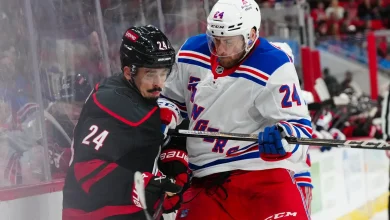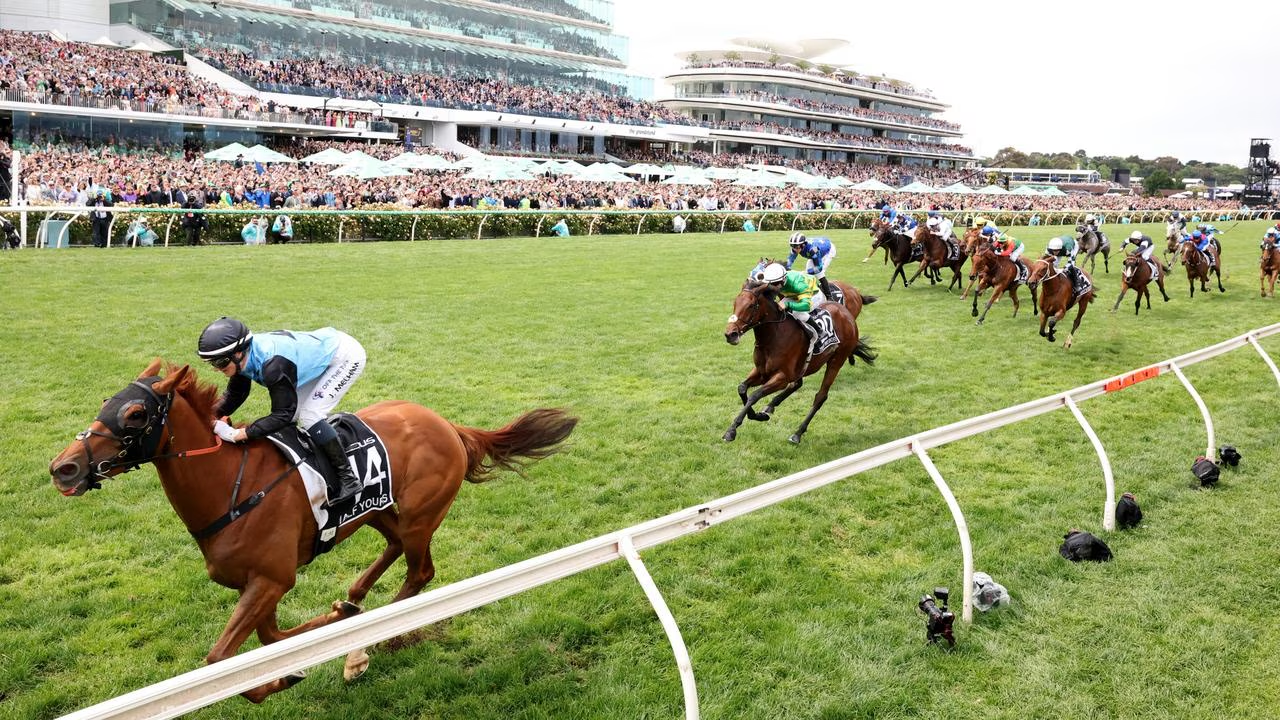How the Blue Jays made it uncool, again, to strike out

Open this photo in gallery:
Addison Barger of the Toronto Blue Jays hits a single against the Seattle Mariners during the fourth inning in Game 7 of the American League Championship Series at the Rogers Centre on Monday.Vaughn Ridley/Getty Images
If you want to understand how the Toronto Blue Jays went from a last place team to playing in the World Series in the span of 12 months, know this: In 2025, they do two things very well – they strike out far less than any other team, and they hit the ball a lot more.
If you’re a casual baseball fan, you might not realize how notable that is. Baseball, as a sport, has in recent years believed that strikeouts are an acceptable cost in the pursuit of the all-mighty home run. The Blue Jays, who hit 53 fewer of them than the Los Angeles Dodgers did in the regular season, have rejected that idea since they started playing this spring.
On Friday, those opposing approaches to hitting, power versus pesky, will be tested in Game 1 of the World Series against the Dodgers – the first time the Jays have played for baseball’s biggest crown in 32 years.
These Blue Jays simply refuse to strike out. Their contact rate in these playoffs, at 82 per cent, is one of the best seen by any team in a decade. For opposing pitchers, they’re like Canadian mosquitoes at dusk – they just won’t go away.
When it comes to hitting for contact, the Blue Jays did it better than any other club in the regular season. They led Major League Baseball in batting average (.265), that old-fashioned statistic that measures hits per at-bats, and had the lowest strikeout rate (17.8 per cent) of any team, according to Fangraphs.com.
In the championship series against the Seattle Mariners, they struck out even less, less than 15 per cent of the time. The Dodgers struck out nearly 25 per cent of the time in their series against the Milwaukee Brewers.
Toronto’s first-year hitting coach David Popkins is hesitant to take credit for the team’s offensive redesign, but his fingerprints are all over it. Under his watch, the Jays have brought back the lost art of contact hitting, and they’ve transformed themselves into a lineup of tough outs that wear pitchers down.
“First of all, we have a really talented high-contact lineup,” Popkins said on Thursday, as the Blue Jays met with the media at the Rogers Centre. “They did some of those things naturally on their own but worked hard and became better at it.”
What the Jays are doing is hardly new. It’s just fallen out of favour in today’s game.
In the late 19th century, an undersized right fielder named Willie Keeler popularized this high-contact, low-strikeout approach with his plan to “hit ‘em where they ain’t.” Like the Blue Jays’ undersized infielder Ernie Clement, Keeler wasn’t looking to hit balls over the fence; he was trying to slap the ball into gaps between fielders.
Open this photo in gallery:
From left to right, Toronto Blue Jays’ George Springer, hitting coach David Popkins and teammate Daulton Varsho chat in the dugout during the team’s batting practice in Toronto on Oct. 3.Sammy Kogan/The Globe and Mail
It should be no surprise that Popkins grew up in San Diego idolizing the Padres’ legend Tony Gwynn. Gwynn was one of the game’s all-time great contact hitters, a batter who seemed to hit pitches as if the ball were on a tee and sprayed them all over the field.
Popkins is particularly skilled at the technical side of hitting, breaking down a batter’s mechanics and timing, helping them make adjustments and getting players to buy into a team approach that involves being unpredictable and wearing out opposing pitchers. He also understands the psychological side of hitting, knowing that hitters can be sensitive creatures who sometimes need a hype man to build up their confidence.
As a career minor leaguer who was undrafted out of college, Popkins gets that hitting is hard and requires constant adjustments.
“He worked like hell to be a hitter,” said Dan Hayes, a senior writer for The Athletic who covers the Minnesota Twins, where Popkins was hitting coach from 2022 to 2024. “So he understands failure and is able to empathize with players, because he’s been there, too.”
Cathal Kelly: Game 1 of the World Series is a must-win for the Blue Jays
Blue Jays give pitcher Trey Yesavage the start in Game 1 of the World Series
In Minnesota, Popkins was beloved by the players for his ability to fix broken swings, think creatively and get the most out of a lineup, Hayes said. The Twins’ hitters produced for him, with a top 10 offence for the three years he was coaching despite their small budget, until the team, beset by injuries, collapsed at the end of 2024 and the owner needed someone to blame. So Popkins was out. He was hired by the Blue Jays almost immediately.
When he left, star Twins shortstop Carlos Correa said Popkins, whom he credited with helping him completely rebuild his swing in 2022, was the best hitting coach he’d ever had.
“The players would do anything for that guy,” Hayes said. “I think one thing he was really good at is recognizing the type of hitters he has. He works with guys and adapts. He doesn’t come in with a one-size-fits-all approach. He comes in with, ‘Hey, this is how you work. I’m going to work around you.’”
With Popkins’ help, the Blue Jays brand of baseball in 2025 isn’t just effective, it’s also fun to watch. It’s the antithesis of the all-or-nothing style of play that baseball lifers complained not that long ago was reducing hitting to three outcomes: home runs, strikeouts and walks.
Open this photo in gallery:
Vladimir Guerrero Jr. hits a single during the eighth inning against the Seattle Mariners in Game 6 of the ALCS on Sunday.Mark Blinch/Getty Images
“The game has gone to a very slow and stagnant pace,” John Smoltz, the Hall of Fame pitcher and broadcaster, declared in 2018. “It’s going to become unwatchable.”
In 2025, the Blue Jays are very watchable. Their hitting philosophy is all about being aggressive in the right spots. Forget patience at the plate – these Jays actually chase a lot of pitches out of the strike zone. And they were only league average when it came to drawing walks this year. Their nemesis, the New York Yankees, actually got more free passes than any other team in baseball in 2025 (but had the sixth-worst strikeout rate in the league, fanning in 23.5 per cent of their at-bats).
For the Jays, it’s about putting the ball in play, forcing your opponent to play flawless defence – while mashing a few well-timed home runs, as well.
Just ask George Springer, whose majestic seventh-inning shot in Game 7 against Seattle had Canadians everywhere jumping out of their seats. In the playoffs, the Jays have proven they can be both pesky and hit for power: No other team has hit more long bombs this postseason (20).
At Rogers Centre, the rooms with a view may top the best World Series seats in the house
Under Popkins, hitters are empowered to be the best version of themselves. In 2021, when Popkins was a young hitting coach with the Great Lakes Loons, a Dodgers-affiliated minor league team, the Loons erupted for 187 home runs in just 120 games.
He had a reputation even back then as a workaholic, someone who devoured data on opposing pitchers to come up with game plans and helped hitters make small adjustments before they fell into slumps. He was the guy who would read books on biomechanics on those long bus rides around the Midwest, when everyone else was watching movies.
Popkins was endlessly curious, studying swing patterns and hours of video hoping to unlock a key that would make a hitter that much better, said Austin Chubb, the Loons’ then-manager and now the Dodgers’ minor league field coordinator.
“I know he had a plan as soon as he took that job in Toronto,” he said. “I’ve never seen a hitting coach quite like him. We miss him.”





